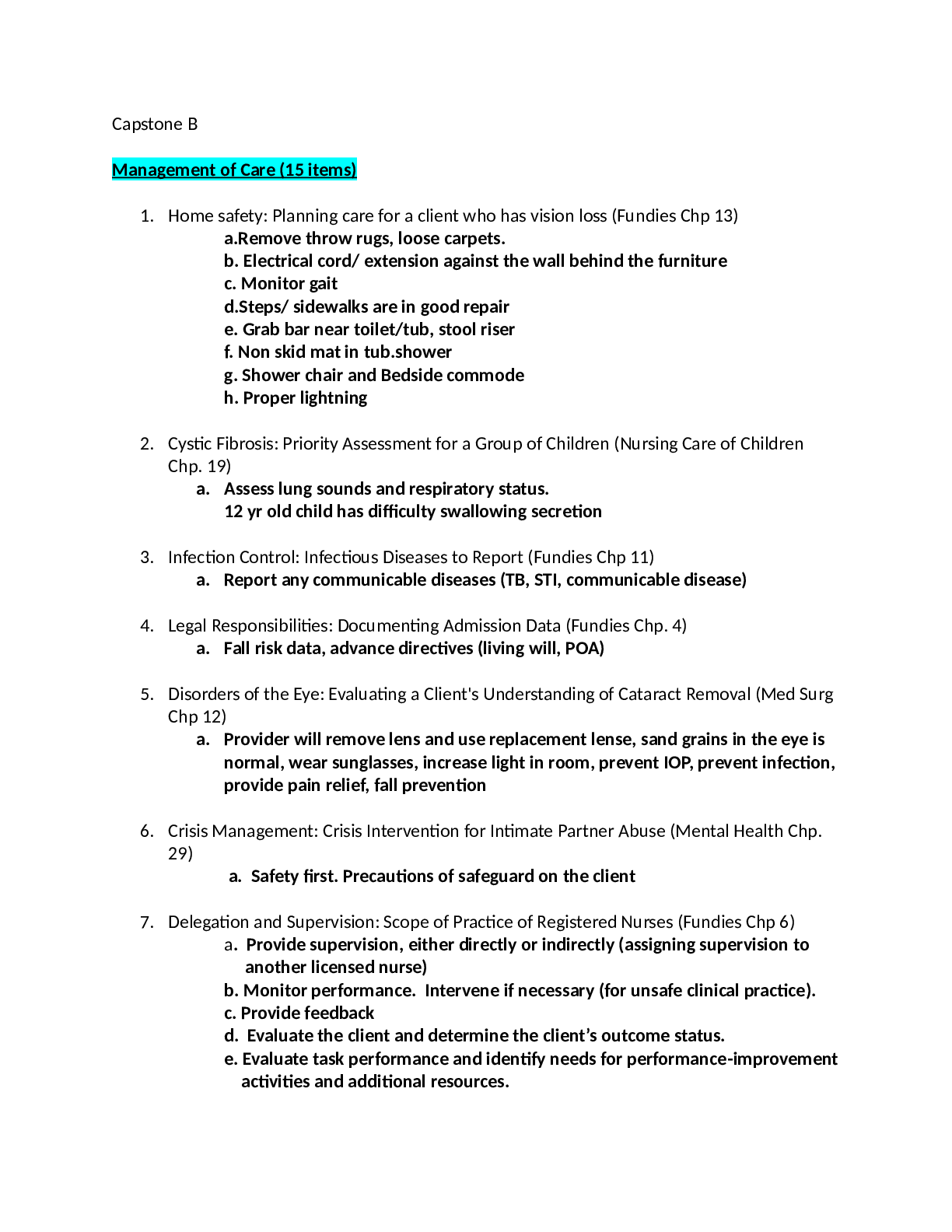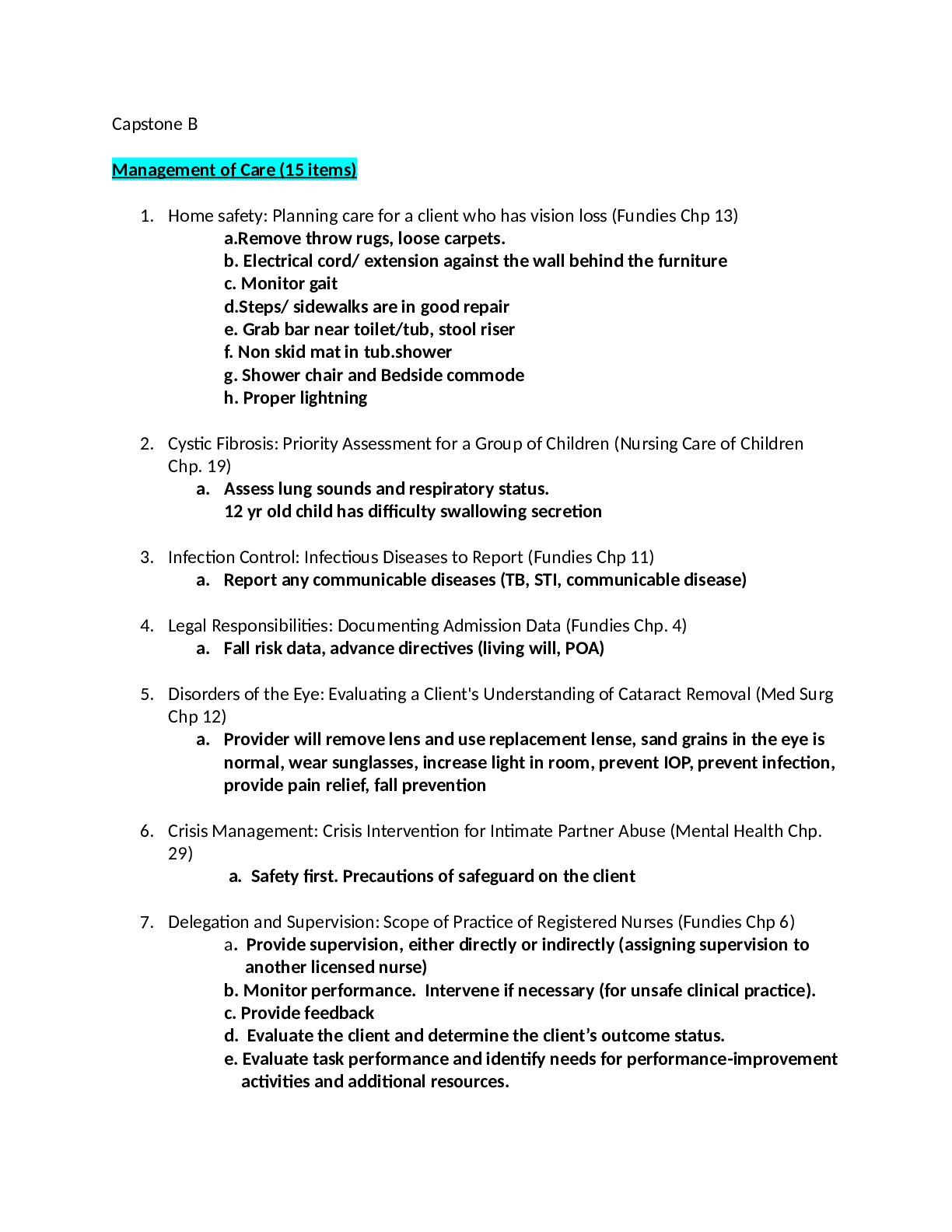Capstone B
Management of Care (15 items)
1. Home safety: Planning care for a client who has vision loss (Fundies Chp 13)
a.Remove throw rugs, loose carpets.
b. Electrical cord/ extension against the wall behind the furniture
c. Monitor gait
d.Steps/ sidewalks are in good repair
e. Grab bar near toilet/tub, stool riser
f. Non skid mat in tub.shower
g. Shower chair and Bedside commode
h. Proper lightning
2. Cystic Fibrosis: Priority Assessment for a Group of Children (Nursing Care of Children
Chp. 19)
a. Assess lung sounds and respiratory status.
12 yr old child has difficulty swallowing secretion
3. Infection Control: Infectious Diseases to Report (Fundies Chp 11)
a. Report any communicable diseases (TB, STI, communicable disease)
4. Legal Responsibilities: Documenting Admission Data (Fundies Chp. 4)
a. Fall risk data, advance directives (living will, POA)
5. Disorders of the Eye: Evaluating a Client's Understanding of Cataract Removal (Med Surg
Chp 12)
a. Provider will remove lens and use replacement lense, sand grains in the eye is
normal, wear sunglasses, increase light in room, prevent IOP, prevent infection,
provide pain relief, fall prevention
6. Crisis Management: Crisis Intervention for Intimate Partner Abuse (Mental Health Chp.
29)
a. Safety first. Precautions of safeguard on the client
7. Delegation and Supervision: Scope of Practice of Registered Nurses (Fundies Chp 6)
a. Provide supervision, either directly or indirectly (assigning supervision to
another licensed nurse)
b. Monitor performance. Intervene if necessary (for unsafe clinical practice).
c. Provide feedback
d. Evaluate the client and determine the client’s outcome status.
e. Evaluate task performance and identify needs for performance-improvement
activities and additional resources.
8. Facility Protocols: Discovering a Medication Errors (Leadership Chp.5)
a. 1st assess client
b. then call hcp
c. Then do an incident report within 24 hrs (AVOID telling client or place in client’s
chart)
d. Submit to risk manager
9. Managing Client Care: Evaluating an Assistive Personnel Performance (Leadership Chp.1)
a. Assist with breakfast with client who has vision loss
i. AP can do ADL, feeding without swallow precaution, positioning, routine
task, i/o, specimen collection, vitals (if client is stable)
10. Continuity of Care: Interventions Promoting Independence (Community Health Chp. 7)
● home health nurse: nursing home, traditional home, assisted living
● -work as part of team, holistic care. nurses, pt, OT, home health aids, social
workers and dieticians part of the care
● -provide skilled assessment, wound care, lab draws, med education, parenteral
nutrition, IV fluids & meds, central line care, urinary catheter insertion and
maintenance, coordination of other participants in health
● -evaluate living environment for safety - older adults= increase fall risk
● -ask about food in home, help with household activities, living alone, support
system, set up and dispense of medications, access to health care
● -encourage clients to be independent and involved
11. Legal and Ethical Issues: Respecting Clients Rights (Mental Health Chp. 2)
a. Veracity- honest, justice- being fair, fidelity- loyal/ faithful, beneficence- doing
good, nonmaleficence- no harm
b. A voluntarily admitted client has the right to apply for release at any time. This
client is considered competent, and so has the right to refuse medication and
treatment.
12. Managing Client Care: Planning an Audit of Quality Control (Leadership Chp.1)
a. Structure audits evaluate the influence of elements that exist separate from or
outside of the client-staff interaction.
b. Process audits review how care was provided and assume a relationship exists
between nurses and the quality of care provided.
c. Outcome audits determine what results, if any, occurred as a result of the
nursing care provided.
d. Retrospective audits occur after the client receives care.
e. Concurrent audits occur while the client is receiving care.
f. Prospective audits predict how future client care will be affected by current level
of services.
NI: nurses use reliable resources, understand facility policies, provide and document
client care, participate in the collection of information/data related to staff’s adherence
Read More


